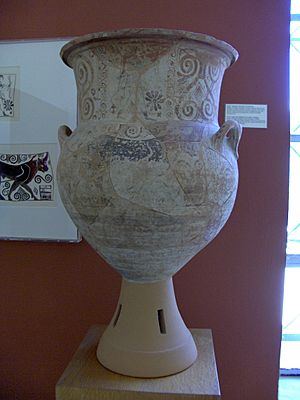Melian pithamphora facts for kids
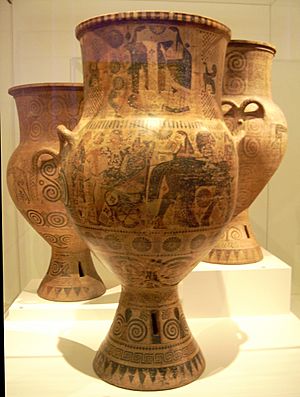
Melian Pithamphorae (say: PITH-am-for-ay) are special, large ancient Greek pots. They are also called Melian Amphorae. These big vases were made in the Cyclades islands during the Archaic period (around 700-580 BC). They are famous because of their unique shape and beautiful painted designs, which show an "Orientalising style" – meaning they were influenced by art from the Near East. People used these amphorae as markers for graves, like tombstones, or as special gifts in temples. When sculptures became more popular for these uses, the making of these vases stopped.
Where Did They Come From?
The name "Melian" can be a bit confusing. In 1862, a researcher named Alexander Conze found the first three of these pots on the island of Melos. He called them "Melian clay pots" because of where he found them. Even though we now know they were probably not made on Melos, the name stuck!
Most experts believe these pots were made on the island of Paros. Some think they might have been made on Naxos, or even that there were two different places making them. It's still a bit of a mystery, and scientists are still trying to figure it out.
Even though only a few of these vases have been found (just eleven in total, nine complete and two broken pieces), they have traveled far! They have been found not just in the Cyclades, but also in Thasos (a Greek colony) and even in North Africa. This shows how important and valued these special pots were in ancient times.
Shape and Decoration
These amazing amphorae can be very tall, up to 107 centimeters (over 3.5 feet) high! They come in two main shapes: an older, wider style and a newer, thinner style. Each pot was made in three clear parts: the main body, the neck (which is almost as wide as the body), and a tall, cone-shaped foot. The foot has small holes to let steam out when the pot was being fired in a kiln.
These pots continue the style of older Cycladic pottery. But unlike earlier, simpler forms, the Melian pithamphorae look more natural and flowing. They have special "belly-handles" on the sides that are horizontal and double. These handles aren't just for carrying; they are also part of the decoration! On some pots, the handles look like goat horns, making the amphora appear like a goat's head. On others, eyes are painted under the handles, making them look like eyebrows.
Every Melian amphora has a main picture on its body. These pictures often show animals, gods, heroes, or monsters. The neck of the pot also usually has pictures, often in square sections called "metopes." The bottom half of the body is usually decorated with two bands of spiral patterns. The foot often has double spiral designs, with geometric patterns above and below them.
The pictures on these pots are usually very graceful and elegant. The artists used a lot of thick, opaque paints. Later examples of these pots show figures in the "Black figure style," where figures are painted in black against the red clay, or they copy the "animal frieze style," which features rows of animals.
Famous Melian Amphorae
Here are some of the most well-known Melian Amphorae:
| Nickname | Image | Location |
|---|---|---|
| Herakles Amphora | 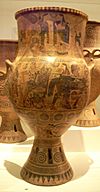 |
Athens, National Museum Inv. 354 |
| Apollo Amphora |  |
Athens, National Museum Inv. 911 |
| Rider Amphora | 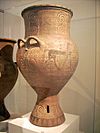 |
Athens, National Museum Inv. 912 |
| Horses Amphora | 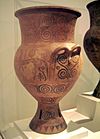 |
Athens, National Museum Inv. 913 |
| Sphinx Amphora | Athens, National Museum Inv. 914 | |
| Dionysos Amphora | Athens, British School | |
| Gerhard's Fragment |  |
Berlin, Antikensammlung Inv. F 301 |
| Conze's Fragment | Bonn, Akademisches Kunstmuseum Inv. 2040 | |
| Neapolis amphora | Kavala, Archaeological Museum | |
| Amphora with depiction of the Judgment of Paris | 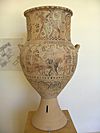 |
Paros, Museum Inv. B 2652 |
| Amphora with depiction of a river scene |  |
Paros, Museum Inv. B 2653 |


